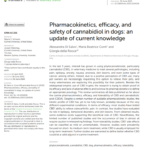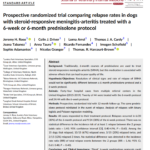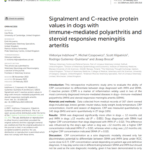scott@vtx-cpd.com
Forum Replies Created
-
AuthorPosts
-
Replying to Josep B. 24/02/2025 - 10:08
It is a really interesting topic!
I am considering it more and more, I have been sing it with some chronic regurgitation/GI cases too.
Scott 🙂
Replying to Josep B. 24/02/2025 - 10:05
Thanks for sharing this, Josep—great summary of CK and its clinical relevance!
I’ve always been a bit unsure about how to use CK effectively, so it was really interesting to explore this further in your recent journal club. The Jones & Harcourt-Brown study was particularly insightful, showing how CK (alongside AST) can serve as a rapid screening tool for Neospora-associated meningoencephalitis. The high sensitivity and specificity at the 485 U/L cutoff make it a useful early marker, though I still wonder about its reliability in milder cases.
In practice, I find CK elevations are often non-specific, especially in medicine cases!
Thanks again.
Scott 🙂
Replying to Josep B. 24/02/2025 - 09:58
Really interesting.
Thank you for sharing.
Scott 🙂
Replying to Rosanna Vaughan 11/02/2025 - 12:36
Hello again.
I had a reply from my contact at Zoetis:
“The SPC’s for GB are on the VMD product database https://www.vmd.defra.gov.uk/ProductInformationDatabase/. Here you will find the most up to date SPC’s for any products registered in GB.”
I hope that helps!
Scott 🙂
Replying to Susana S. 25/02/2025 - 09:17
Thank you again Susana!
I hope you had a lovely holiday.
Scott 🙂
Josep, what are your thoughts on this paper?
J Vet Intern Med. 2024 Jul-Aug;38(4):2221-2227 – a prospective randomized trial comparing relapse rates in dogs with SRMA treated with either a 6-week or 6-month prednisolone protocol.
A few key takeaways:
Both groups had similar response rates.
Relapse occurred in 30% (6-month protocol) vs. 38% (6-week protocol), but there was no statistically significant difference between them (P = 0.60).
Among relapsed cases, most dogs only relapsed once, with very few having multiple recurrences.
Suggests a shorter steroid course may be viable, potentially reducing adverse effects and improving quality of life.
Given the historical reliance on prolonged immunosuppression for SRMA, do you think this study is enough to shift treatment protocols towards shorter courses? Or are there limitations that make you hesitant to change standard practice?Does this change your tapering approach? What is your current approach to tapering in SRMA cases?
Scott 🙂
Replying to Josep B. 24/02/2025 - 10:13
“I know a really good paper on this topic… oh wait… did we write that?! 🙂
For anyone who somehow hasn’t read this masterpiece yet, let me summarize:
Front Vet Sci. 2023 Feb 14:10:1091318 – a fine example of scientific rigor, if I do say so myself! In this multicentric retrospective study, we analysed data from 167 dogs diagnosed with either SRMA or IMPA, looking at how CRP concentrations varied between the two diseases.
Key findings:
SRMA was significantly more common in dogs <12 months old, whereas IMPA was more frequent in dogs ≥12 months old (P < 0.001). Dogs with SRMA had higher CRP concentrations than those with IMPA (P = 0.02). However, CRP’s diagnostic role wasn’t as straightforward as expected—its predictive value actually shifted with age. In dogs <12 months old, higher CRP was paradoxically more suggestive of IMPA (P = 0.02). In dogs ≥12 months old, higher CRP was more indicative of SRMA (P = 0.02). When looking at overall discriminatory ability, CRP alone was only fair at differentiating between the two (ROC AUC ~0.7), meaning it shouldn't be used as a sole diagnostic tool. Take-home message: CRP is a useful marker of inflammation, but interpreting it in the context of SRMA vs. IMPA requires nuance—particularly considering patient age. It’s another reminder that clinical context always matters! Nothing like a bit of shameless self-promotion. Scott 🙂
This is a fascinating topic!
Looking forward to hearing peoples thoughts on this one!
Hope everyone has a great week.
Scott 🙂
Replying to Stephanie B. 23/02/2025 - 13:31
No problem!
Hope all is well with you. Let us know if you have any other questions.
Scott
Hey.
I thought I would share a discussion from our members clinical discussion forum where were were discussing this exact topic:
Question:
Paracetamol in liver disease
We had a bit of a debate today regarding use of paracetamol in a dog with a confirmed liver neoplasm – if I had to guess from gross appearance I would say it appears aggressive and malignant. Liver parameters (ALT/ALKP) markedly raised.
Is paracetamol safe to use? I feel I have always thought ‘paracetamol is contraindicated in hepatic disease’. However, my colleagues suggested otherwise. So I feel a little confused!
Response:
Hi Laura,
That’s a great question, and I completely understand your hesitation. The traditional teaching has been that paracetamol is contraindicated in liver disease, but more recent evidence, particularly from human medicine, suggests that the reality is more nuanced.
In human patients with chronic liver disease, paracetamol is actually considered the first-line analgesic due to its relatively safer profile compared to NSAIDs and opioids. Prospective studies have shown that even in cirrhosis, therapeutic doses up to four grams per day for thirteen days were well tolerated. The primary concern with hepatotoxicity comes from overdose or in patients with additional risk factors such as alcoholism, fasting, malnutrition or febrile illness, all of which can contribute to glutathione depletion and increase the risk of NAPQI toxicity. Interestingly, studies indicate that the metabolism of paracetamol via glucuronidation and sulfation remains largely intact even in moderate to severe liver disease, with only a slight prolongation of half-life. Importantly, there has been no strong evidence that chronic liver disease itself significantly increases NAPQI production in the absence of other compounding factors.
That being said, the situation in this dog is different from stable chronic liver disease. Here, we are dealing with a confirmed liver neoplasm that, from gross appearance, seems aggressive and malignant, alongside significantly elevated ALT and ALKP. While we do not have a perfect veterinary parallel to human studies on paracetamol in liver disease, the presence of a tumor introduces additional uncertainties. Liver neoplasms, particularly aggressive ones, can disrupt normal hepatic metabolism in unpredictable ways, potentially impairing glucuronidation and glutathione-dependent detoxification of NAPQI. This makes the risk of hepatotoxicity harder to assess.
It is also worth considering that idiosyncratic drug reactions can occur with many medications, including those we otherwise consider safe, and paracetamol is no exception. Most drugs undergo some degree of hepatic and renal metabolism, and while the impact on these organs is usually predictable, unexpected adverse effects do happen. In a compromised liver, even drugs that are typically well tolerated can have altered pharmacokinetics and pharmacodynamics, potentially leading to increased toxicity. This is particularly relevant when hepatic metabolic pathways are already under strain due to disease, inflammation or neoplastic infiltration.
In a dog with stable liver disease and intact synthetic function, I might consider a cautious, low-dose approach with monitoring. However, in this case, given the unknowns surrounding liver function and the already elevated liver enzymes, I would be inclined to avoid paracetamol altogether if possible. There are safer alternatives for analgesia, including gabapentin, amantadine and opioids such as buprenorphine or fentanyl. If paracetamol were absolutely necessary, I would opt for a significantly reduced dose of ten milligrams per kilogram or less with close monitoring of liver function, including synthetic markers like albumin, bile acids and coagulation parameters.
So, while your instincts about paracetamol being contraindicated in hepatic disease are generally correct, the discussion is evolving and there are situations where it can be used safely. However, in this particular case, with a potentially compromised hepatic metabolism due to neoplasia, I would err on the side of caution and look for alternative analgesic options. Given the unpredictability of drug metabolism in compromised livers and the potential for idiosyncratic reactions, a conservative approach seems safest.
Let me know your thoughts. I will ask our anaesthetist, Felipe, for his comments too.
Best,
Scott 🙂
Hi Laura and Scott
What an amazing and interesting topic, which is discussed a lot everywhere I find.
I honestly doubt there is any way I can give any more scientific background information than Scott has already done. What a great summary, thanks for that Scott.
I completely agree with Scott. With all that scientific background in hand, and looking at what our human anaesthetist counterparts do, paracetamol does seem to be accepted as quite safe in many scenarios, and have a fairly wide therapeutic window. This is even reflected by its wide dosing regimes that can be read on the BNF NICE guidelines. This seems to be consistent in dogs where we know acute single dose toxic levels in dogs were reached around 75 to 100mg/kg (not that I would ever recommend getting even remotely close). Cats are obviously a totally different case.
These cases where there is uncertainty about the competency of the metabolic routes and the handling of NAPQUI are certainly tricky and I would therefore stay away from it. Unfortunately we just do not have the large population data to understand better the suitability in these disease processes. All the decisions we make for our patients are risk-benefit assessments, and I would find quite hard to justify any considerable risk for the benefit achieved through paracetamol therapy, if we have other options, many of which yield superior analgesia.
I would also argue that given the lack of data, the inherent potential hepatotoxicity, and the fact that the only paracetamol preparation licensed in dogs has a literal contraindication in liver disease, should we be so unlucky to find the patient that was not fit for paracetamol, we would have a very hard time legally justifying our choice.
In general, I have to admit that although I do love paracetamol for most canine patients, I am often quite defensive in its use in hepatic disease cases. Even if I know in many cases the patient would almost certainly be fine with paracetamol, I steer away from using it if I can find another alternative. If there is no other alternative, an honest discussion with the owner with paper trail of our reasoning and written consent seems sensible.
In terms of considering dosing adjustment for these animals, and expanding on what Scott rightly said, I personally end up finding that if I am worried about accumulation (which I guess could saturate metabolic routes/deplete our beloved glutathione in impaired animals) and I am not able to predict pharmacokinetics, it’s another reason for me to just not use it. Lowering the dose obviously makes sense if accumulation is likely, but if plasma levels are too low we risk not yielding a clinical effect. So if I still were to go ahead with this, I would go with the lowest of the dosing that we know have a clinical effect but consider decreasing the doses per day to allow for a longer half life (for example to q12h or even q24h), rather than preserving a TID regime with lower dose which might not yield high enough plasma concentration, or rely on a very difficult to predict (and potentially dangerous) accumulation to do so. When pharmacokinetics start getting messy I tend to throw my toys out of the pram, but this is just my personal opinion, not necessarily the best one! In any case, monitoring, as Scott said, would be very important.Hope this helps!
Felipe
Another great question!
Scott 🙂
Hello Raquel,
Thank you for your message and for sharing your experiences with recent anal gland cases, it is great to hear how the webinar helped guide your discussions and approach. Below is some further information regarding Anal Sac Disease (ASD), along with the Royal College of Veterinary Surgeons (RCVS) advice on anal gland expression.
RCVS Advice: “External expression of the para-anal sacs (also known as anal glands) is a procedure that may be undertaken by competent owners or lay people (i.e., those who have had the procedure demonstrated and explained to them by a veterinary surgeon). Routine, prophylactic expression of anal glands should only be undertaken on the advice of a veterinary surgeon. If a para-anal sac problem is suspected, the animal should be seen by a veterinary surgeon for confirmation of the diagnosis and advice regarding any necessary treatment. Internal expression of the para-anal sacs per rectum amounts to the practise of veterinary surgery. This means that it may only be undertaken by veterinary surgeons or student or registered veterinary nurses working under the direction of their veterinary surgeon employer.”
Diseases of the Anal Sacs (ASD): Nonneoplastic anal sac disease (ASD) encompasses impaction, sacculitis, and abscessation. An English study cited anal sac impaction as the third most common reason that dogs were presented to primary care facilities. Overrepresented breeds include Cavalier King Charles Spaniels, Labrador Retrievers, Chihuahuas, and Miniature Poodles. Cats are less frequently affected. Pathogenesis often remains unknown, but altered composition of anal sac secretions may play a role. Predisposing factors include smaller duct openings, chronic diarrhoea, seborrhoea, obesity, and poor muscle tone. Clinically, dogs with ASD commonly present with scooting, licking, or chewing at the anal region. Conditions that mimic ASD, such as anal sac neoplasia, flea allergy dermatitis, and fungal disease, must be ruled out. Cytology alone may be nondiagnostic because healthy dogs can have variable WBCs and bacteria in their anal sacs. Treatment depends on severity. Impactions may resolve with flushing, warm compresses, local antibiotic instillation, and topical corticosteroids, while abscessation may require surgical removal (anal sacculectomy). Prognosis hinges on identifying and controlling underlying causes; complications of surgery can include faecal incontinence, tenesmus, and anal stricture.
Although I have never personally used Glandex, the product and similar supplements often contain fibre, probiotics, and soothing ingredients that may support healthy anal gland function by promoting optimal stool consistency.
Thank you again for your thoughtful insights and for engaging with the webinar content. If you have any further questions or would like to discuss specific cases, feel free to reach out. I would be interested to hear others thoughts on Glandex.
Kind regards,
Scott 🙂
Replying to Maria G. 11/02/2025 - 14:37
Hello Maria!
There does seem to be an issue with these notes!
Really sorry about this. What is you best email? I will get them sent through to
you!I hope you have enjoyed the course. Sorry again.
Scott 🙂
Replying to Rosanna Vaughan 11/02/2025 - 12:36
This is also helpful:
Scott 🙂
Replying to Rosanna Vaughan 11/02/2025 - 12:36
Great question!
Let me go back to Zoetis and get this information to you!
I hope you are well.
Scott 🙂
-
AuthorPosts




